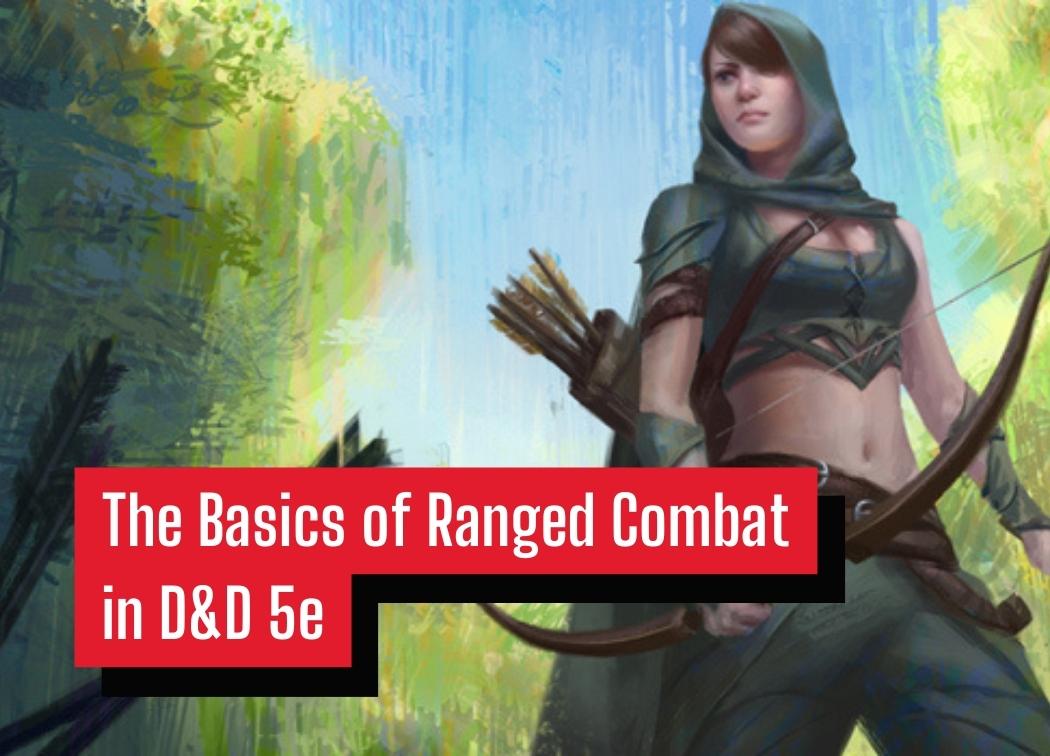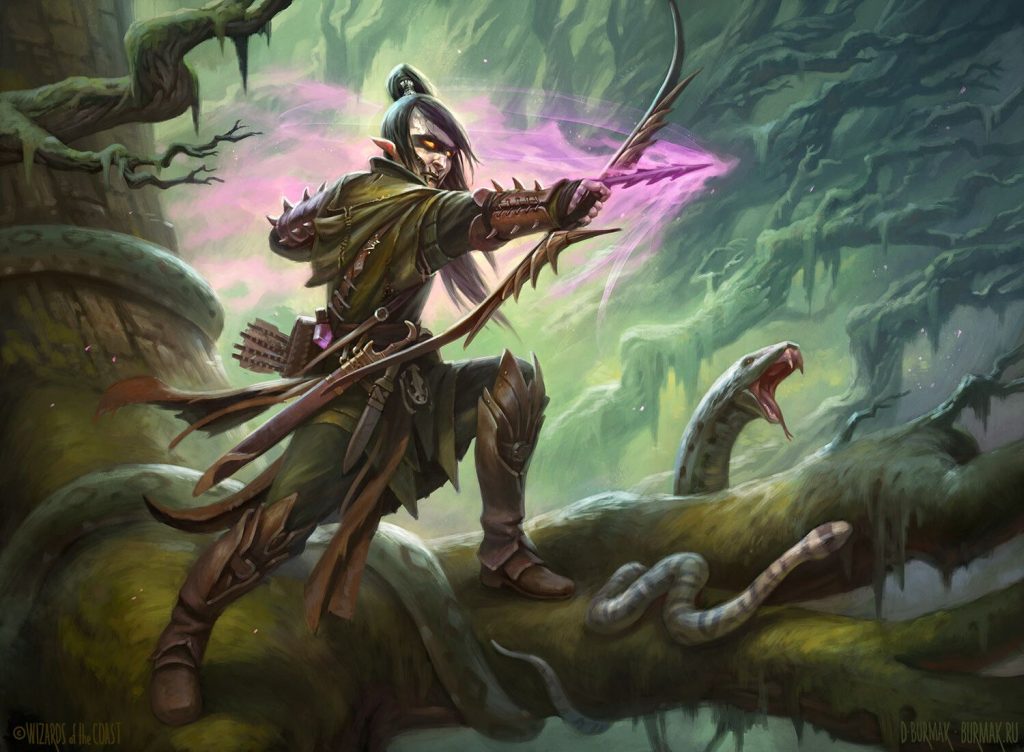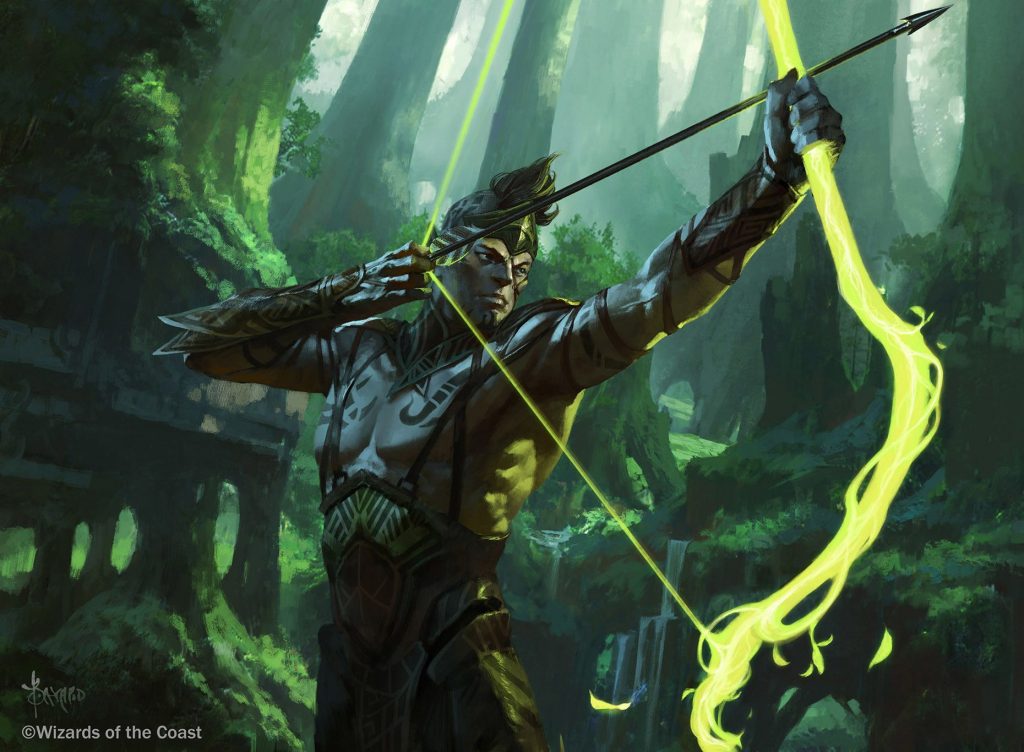The Basics of Ranged Combat in D&D 5e

A while ago I told an outright lie. I said that dual wielding was the coolest style of combat. Maybe that’s not a lie, but it’s certainly not the most effective combat style in D&D 5e. With that in mind, let’s look into ranged combat which is undoubtedly one of the best combat styles in 5e.
Ranged attackers have it all. They can hit hard, have tons of character customization options, and, best of all, don’t have to stand near enemies to deal damage! If you utilize a bow or a crossbow in combat you can attack safely from afar while the party’s melee attackers tank the enemy’s attacks.
Sure, on average you’ll deal a bit less than a typical great weapon fighter, but you’ll also be much more accurate and most importantly, considerably safer. That’s the trade-off between melee and ranged attackers, you’re trading a higher damage per round for safety.
Yeah, there are thrown weapons too, but we don’t talk about those. Ok, fine, I’ll do a write-up on thrown weapon fighting once they get some love outside of the latest Unearthed Arcana. For now, let’s stick to bows and crossbows.

The Mechanics of Ranged Attacks
A ranged attack at face value is no different than any other attack in D&D 5e. You simply roll 1d20 and add your ability modifier and proficiency modifier to the result of the roll as required. For most ranged weapon attacks the ability modifier you’ll use will be your Dexterity modifier.
As always, read up on what ability your weapon uses, but for bows and crossbows, it’ll always be Dexterity unless your DM gives you something special.
The primary consideration that any ranged combatant has to make is their positioning. You cannot be too close or too far from your target if you hope to be effective in combat.
Most melee combatants also don’t have to consider cover when they make their attacks. As a ranged attacker, cover will be a regular thorn in your side. If an enemy hides behind some terrain they will gain a bit of a boost to their AC against your attacks, or if they’re fully-covered you can’t target them at all. Again, you’ll need to consider your positioning to be effective in these situations.
Positioning is everything for a ranged combatant. You can’t just run up to a creature and hit them. It requires a bit more thought and finesse! Let’s go into a bit more detail with regards to ranged combat’s unique mechanics and problems.
For the record, all of the mechanics that we talk about in this article can be found in the Player’s Handbook.
Ammunition
A minor drawback of being able to sling projectiles at an enemy from a safe distance is that you have to buy all those projectiles in the first place. Honestly though, if the cost of my safety is a few silver every couple of adventures then so be it.
Whenever you make a ranged attack, you draw a single piece of ammunition during each attack. This can add up to quite a few projectiles used each adventure pretty quickly for groups that diligently track their ammunition, but again, that’s the cost of your safety.
Thankfully though, if you spend at least one minute after each combat searching the battlefield you can recover up to half of the ammo you expended. Well, provided that the ammo doesn’t explode and isn’t magical. This is a nice way to recoup the cost of all of those projectiles though.
Ranges
We’ve touched on this subject before, but all ranged weapons have a range property that has a value of (X / Y) listed in feet. The X value is the weapon’s normal range, meaning that you can make attacks without any issues if your target is within that range.
The Y value is the maximum range of the weapon. What this means is that if your target is between X-Y feet away from you, you can attack it, but you do so at disadvantage. Being able to attack a target at long range is a nice perk, but you’ll have to determine if attacking at disadvantage is a worthwhile use of one of your attacks.
For a quick example of what this means, let’s take a look at the shortbow which has a range of 80/320 ft. A character can make attacks between 6-80 ft. normally. They can attack creatures between 81-320 ft. of them, but these attacks are made at disadvantage.
Close Combat
Your positioning on the battlefield is your primary concern as a ranged combatant. If you’re too far from an enemy you’ll be attacking at long range and will have disadvantage on your attacks which is not ideal. However, you’ll also have disadvantage on any attacks made against enemies that you’re too close to!
That’s right, if you are engaged with an enemy you’ll have disadvantage on attack rolls. Engaged being within 5 ft. of an enemy. Keep in mind that this is not just for that creature if you are too close to any hostile creature you’ll have disadvantage on your attacks until you move away from them.
Keep in mind that this rule also includes spell attacks, not just attacks made with ranged weapons!

Improving Your Ranged Attacks
The cool part about playing a martial character is that you have a plethora of features, feats, and equipment choices to help optimize your build. You don’t have spells like magic-users so instead, you need to spend your ASIs wisely to squeeze the most value out of your attacks!
Keep in mind that there certainly are other options for improving your combat capabilities. These are just the most notable options in my opinion. Feel free to add more in the comments, though!
Fighting Style: Archery
Most of the martial classes in 5e gain a feature called Fighting Style. Each class has a unique list of options you can choose from when you gain this feature and each option enhances your ability to utilize a specific style of fighting.
The fighter and ranger both have an option called Archery which grants you a flat +2 bonus to any attack rolls made with ranged weapons.
It’s certainly not a flashy bonus, but my gods a consistent +2 to attack rolls is a huge bonus, especially when paired with a feat like Sharpshooter which allows you to trade accuracy for damage. Improving your chance to hit is arguably more valuable than increasing your damage especially with ranged attackers who have to consider cover when making their attacks.
Accuracy is king and Fighting Style: Archery gives you a healthy +2 boon to your accuracy. There’s no reason to look at any other Fighting Style if you are making a ranged combatant character.
The Sharpshooter Feat
Great Weapon Master and Sharpshooter are two of my favorite feats as they both give you a “power attack“ option. What? I like big hits!
Seriously though, the “power attack” mechanic in 5e allows you to attack a -5 penalty to hit, but you gain +10 damage if the hit connects. This is an excellent perk for a player who loves high-risk, high-reward playstyles, and our Fighting Style already helps offset the penalty.
This feat is stuffed with value though, so you’re not just getting the “power attack” option. You also are now able to completely ignore half cover and three-quarters cover which is just fantastic.
But that’s not all! You can also attack at long range without having to make your attacks at disadvantage. Congratulations, you can now use your longbow to shoot any creature within 600 ft. of you so long as they don’t have full cover.
If you are playing a ranged attacker, Sharpshooter should be at the top of your list when you go to spend your next ASI. Even if you never use the “power attack” part of the feat, the rest of the feat is still worth the price of admission.
Oh, I’ve also made a calculator to help you figure out when you should be making a “power attack” with Sharpshooter. Check it out here!
The Crossbow Expert Feat
Bows may be my weapon of choice for my ranged characters, but that doesn’t mean that crossbows don’t exist!
Crossbow Expert is yet another ranged combat-focused feat that piles on a heaping load of value on top of your character. For starters, you can now ignore the loading quality of crossbows which prevented you from using your Extra Attack feature with a crossbow, so now you can compete with a bow-user.
The feat also allows you to handwave the negatives of being engaged with a hostile creature. You can now continue firing at enemies without having to worry about that source of disadvantage! This is particularly useful for hand crossbow users who have a much shorter range than most ranged combatants.
Finally, you can use a bonus action to attack with a loaded crossbow that you are holding provided that you used the Attack action to attack with a one-handed weapon. Again, hand crossbow users rejoice because you just increased your action economy!
All in all, this is a staple feat for anyone itching to use a crossbow as their ranged weapon of choice. Doubly so if you are leaning towards using a hand crossbow as you can pick up a sweet additional attack through the cost of one bonus action.
The Elven Accuracy Feat
While this feat is not made solely for ranged combatants, it still winds-up being an exceptional feat for a ranged attacker to take. Well, provided that they are either an elf or a half-elf as this is a racial feat.
What Elven Accuracy does is that it allows you to reroll one of the d20s used to make a weapon attack using Dexterity provided that you have advantage on the attack. This effectively gives you “super advantage” on any ranged attack by rolling 3d20 instead of 1d20 to attack.
This is a particularly great feat if you can reliably get advantage on your ranged attacks, so a rogue or a character with a 2-level dip in rogue could certainly make great use of this feat.
Elven Accuracy is a half-feat meaning that you can increase your Dexterity (or a choice between a few other ability scores) by +1 while still gaining the customization benefits the feat provides.
Conclusions
All in all ranged combat is a combat style that is both satisfying and safe to use. You can sit from an ideal position and shoot your foes down while the party’s melee combatants soak up all of the damage for you.
Positioning is key for anyone who wishes to excel in ranged combat. While taking Sharpshooter does hand-wave most of your worries regarding cover, you still need to be sure that you’re able to both see your target and you’re not too close to the target. Well, unless you picked up Crossbow Expert as well.
Ranged combat is even important for characters that prefer to use melee weapons. There will certainly be times where you’ll have to sheath your axe and draw your dusty bow to provide a bit of damage to enemies that can fly or easily avoid engaging you in melee range.
So take up a bow, take up a crossbow, or even take up a gun if your DM lets you. Ranged combat is a fantastic playstyle for those who put the time and resources into it!
